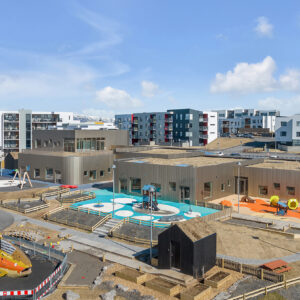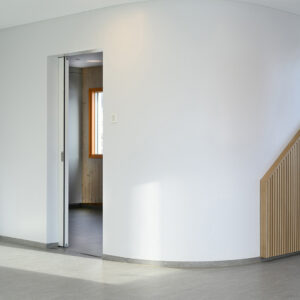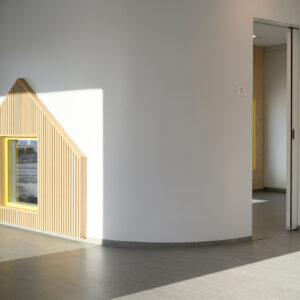Running riot, laughing, playing, shouting, crying – it’s rarely quiet in places where children are gaining important experience for their development. However, in the long run the noise becomes a challenge, not only for the adults but also the children themselves. In a play school in Iceland, they have now succeeded in creating smooth transitions with tightly closing sliding door hardware which provides orientation for different phases of activity and creates a quiet environment when the children need a breather.
Before they start school at the age of six, Icelandic children attend the so-called Leikskóli, a play school – often already at the young age of one or two. As an all-day care facility, it is a combination of a nursery, a kindergarten and a preschool under one roof. Each school can determine the content of the framework curriculum for the Leikskóli itself. In Garðabær, south of Reykjavik, the main focus for the approximately 130 children is on having everyday experiences which have been tailored to their needs. The building was designed by architect Hulda Jónsdóttir and her office HJARK Architecture and Design and SAstudio.
Hulda Jónsdóttir designed the interior specifically for the children: The centerpiece is a hall which runs through all parts of the building. This is where the children enter and follow colored lines on the floor, which lead to their group. Each of the three age groups has an area of the building that is specially tailored to them, with ceiling heights that vary according to the size of the children. Between the three group areas there is a library, a communal room, a greenhouse and a large kitchen. The large glass fronts mean that the children can watch how their home-grown vegetables ripen in the greenhouse and are processed in the kitchen.
All of the rooms are warm, bright and friendly: With white walls, lots of wood, light grey linoleum floors and colorful window frames. Large windows and skylights let plenty of daylight into the interior. The cleverly thought-out lighting provides a bright atmosphere in the dark winters.
Flowing transitions
For the architect, the carefully designed interior also includes targeted management of the room relationships: “It was important to me for there to be a flowing transition between the rooms when the doors are open,” explains Hulda Jónsdóttir. It therefore seemed obvious to her that only sliding doors would be used in the Leikskóli; hinged doors would have ruined this impression.
The situation would also have been less clear, she says. “I like the clear message: When the sliding doors are open, they children are invited to run around freely. If they are closed they form a part of the wall, which signals to the children not to go into the other room.” Depending on the time of day, the children can move freely between the leisure area, the quiet room and the dining room. On the other hand, at least the door to the quiet room remains closed during the midday nap.
Space-saving flexibility
Working in small groups or playing freely all together – all made possible by skillfully positioned connecting doors which flexibly organize the areas of the play school. Sliding doors that do not cause an obstruction also play to their strengths here: “With a closed sliding door, the rooms can be used to an equal extent at both sides, since they visually form part of the wall,” explains Jónsdóttir. This allowed her to design the building in a flexible way, without wasting a single square meter of valuable space.
Challenge Sound attenuation
The biggest challenge in finding suitable sliding doors was ultimately sound attenuation, reports the architect. In the quiet rooms, the children should be protected from the surrounding noise. Overall, the specifications of the Nordic Swan label had to be fulfilled. “We spent a great deal of time looking for sliding solutions with sound attenuation,” says Jónsdóttir, “because without them it would not have been possible to implement our design.”
There are now 16 sliding doors in the Leikskóli in Garðabær. They separate the quiet rooms from the other areas and provide smooth, obstacle-free transitions between the leisure areas and the communal areas, which are connected wall to wall. Two sliding hardware systems with all-round seals were used in the form of “Hawa Junior Acoustics” and “Hawa Porta Acoustics”. They ensure that the noise situation from room to room is noticeably reduced when the door is closed – by up to 39 decibels with the “Hawa Porta Acoustics” and even up to 41 decibels with the “Hawa Junior Acoustics”. However, tight closing with a high sound attenuation value does not only provide protection from noise. It also keeps out light and drafts, which also ensures that the children can have a relaxing midday nap.
They have had good experiences in everyday situations, says Hulda Jónsdóttir: “The staff are very satisfied with the sound attenuation, and the sliding doors are also easy for the children to open and close.”
Room acoustics as a quality feature
Sound attenuation has often been neglected in daycare centers in the past. Fire safety and energy saving measures, hygiene costs and care costs, on the other hand, determine the architecture of many educational institutions. This leads to an open design with large glass surfaces, parquet floors or hard materials such as tiles and stone, which, in conjunction with many different sound sources, results in poor room acoustics with frequent sound reflection and long reverberation times.
However, the example of the Icelandic play school shows that sound attenuation and room acoustics should already be taken into account at the planning and construction phase. After all, these do not only help children to achieve a balanced relationship between activity and rest, but also help adults to achieve better work quality. The project was the result of a competition, and is part of the new Eco-quarter. The building therefore had to be certified according to the strict environmental standards of Nordic Swan, which has regulations regarding energy consumption, materials and daylight as well as regarding noise pollution.
Images in high resolution
Please, click on the thumbnail for pictures in high resolution format.
 Caption 1: The Icelandic play school is a part of a new Eco-quarter. The building therefore had to be certified according to the strict environmental standards of Nordic Swan, which has regulations regarding energy consumption, materials, daylight and noise pollution.
Caption 1: The Icelandic play school is a part of a new Eco-quarter. The building therefore had to be certified according to the strict environmental standards of Nordic Swan, which has regulations regarding energy consumption, materials, daylight and noise pollution. Photo: Marino Thorlacius
 Caption 2: The idea was for the rooms of the Icelandic play school to flow into one another when the doors were open. This is why sliding doors were used. Photo: Marino Thorlacius
Caption 2: The idea was for the rooms of the Icelandic play school to flow into one another when the doors were open. This is why sliding doors were used. Photo: Marino Thorlacius Caption 3: A clear message: If the sliding doors are open, they invite the children to run around freely. If they are closed they become a part of the wall, which signals to the children that they should not go into the other room. During the midday nap, the door to the quiet room remains closed and also blocks out noise. Photo: Marino Thorlacius
Caption 3: A clear message: If the sliding doors are open, they invite the children to run around freely. If they are closed they become a part of the wall, which signals to the children that they should not go into the other room. During the midday nap, the door to the quiet room remains closed and also blocks out noise. Photo: Marino Thorlacius





